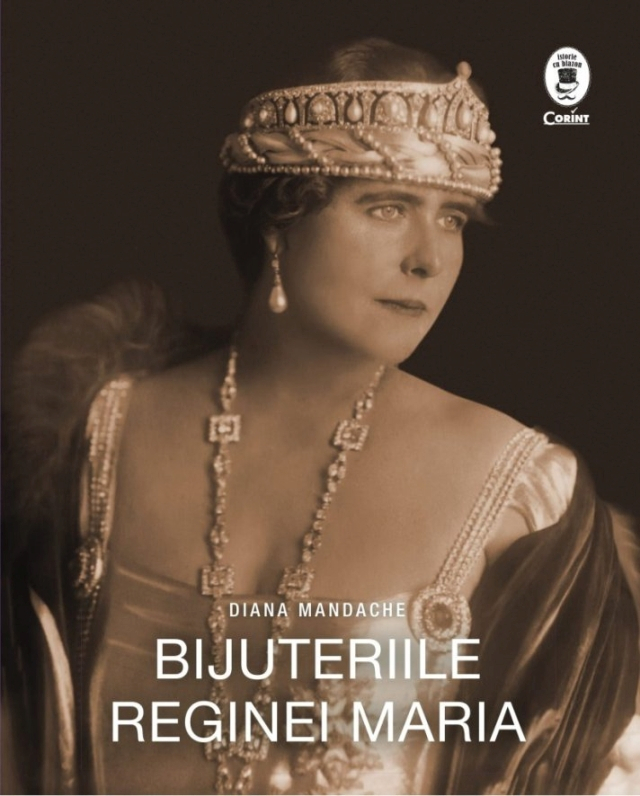Queen Marie’s Jewels
New book sheds light on Queen Maries collection of jewellery.

România Internațional, 31.03.2019, 10:54
Queen Marie reigned
as King Ferdinand’s wife between 1914-1927. She was born in 1875 and was one of
the grand-daughters of Queen Victoria of Great Britain. Her father, duke Alfred
of Edinburgh, was the British sovereign’s second son. She was also a first
cousin of the last tsar of Russia, Nicholas II, through her mother, the Grand Duchess
Maria Alexandrovna.
Queen Marie, highly
appreciated for the big diplomatic efforts she made to support the Great Union
of 1918, was a fascinating, strong personality, a fierce supporter of arts and traditional
culture. Just like with other monarchs, her public duties and personal life
intertwined, and an apparently intimate story, such as that of her personal jewellery,
was very much influenced by the historical events that Romania went through in
the 20th century. They say her collection included no less than 400
items, pieces of jewellery and precious stones. Unfortunately, most of them
have gone lost, and they are now impossible to recover. Their unofficial
inventory has been recently made in the book Queen Marie’s Jewels, written by
Diana Mandache and published by the Corint publishing house. The urge to write
such a book came when the author discovered in the archives of the National
Council for the Study of the Securitate (political police) Archives, drawings
and watercolours illustrating an important part of the Queen’s jewels. These images,
alongside period photos and portraits, were the starting point for Diana
Mandache, who embarked on a journey to recreate the history of Queen’s jewels,
starting from those inherited from her famous grandmother, Queen Victoria. Diana
Mandache:
From the Victorian
age, two interesting bracelets have made it through several changes in
political regimes and legislations. One of them had belonged to Queen Victoria.
It has hearts and turquoises with hair strands of her first four children
embedded in them. The other one is a golden bracelet, adorned with painted
miniatures, portraits of the children of the Duke of Edinburgh, Queen Marie’s
father, including that of princess Marie of Edinburgh, the future Queen Marie
of Romania. Although these jewels belonged to private collections, they were
seized by the communist regime. It was a Bolshevik habit, adopted by the
communists in Romania after 1948. Moreover, some jewels were not registered,
but they were dismantled, because they were made of parts that could be turned
into smaller pieces.
In addition to the
jewellery inherited from her grandmother, queen Marie received several pieces
as part of her dowry, when she married King Ferdinand. All of them, however,
would later be taken to Russia, along with the Romanian treasure, when the
country entered WWI in 1916. Only part of the treasure has been recovered and
the Queen’s jewels are unfortunately lost for good. Here is Diana Mandache
again:
The first train
carrying part of the Romanian Treasure left for Moscow on December 14, 1916,
together with the two iron boxes with Queen Marie’s jewellery. The two boxes
were sent to Moscow without any prior inventory, and that is evidence of the
haste in which everything was done. A piece of news broke in 1920, via a
diplomatic channel, about the Bolshevik Lev Kamenev selling part of Queen
Marie’s diamonds in London, not through auction houses, but through private
collectors. Similar information emerged in 1921, namely that some of Queen
Marie’s jewels were sold to private collectors in the Scandinavian countries.
After the war, at the peace conference in Paris, when she carried ad-hoc
diplomatic negotiations, defending Romania’s interests, she wore no jewellery
at all. She actually wrote about that in her journals and letters. Secondly,
she wanted to highlight the matter before the Reparation Committee at the Paris
Conference, which discussed the return of the Romanian treasure.
After the great Union
of 1918 and the coronation of 1922, Queen Marie’s jewellery collection started
to be restored through acquisitions, made primarily by the king. Here is Diana
Mandache once again:
He purchased for
Queen Marie a sapphire and diamond tiara, from her sister Victoria Melita.
Then, Ferdinand bought the famous Cartier necklace, with a huge, quite unique
sapphire. Of course, through the Romanian Parliament, the crown was ordered
from the Falize jewellery house. The crown was an exceptional item, with a very
special design, famous for the combination of gems and the Transylvanian gold
it was made of. Most of the items that
have remained in Romania, the most precious of them, were distributed, after
1948, to the Finance Ministry and the National Bank, or the State Bank, as it
was known in communism. After that, they were also distributed to some museums.
In her will, Queen Marie left all her jewellery to her family. Obviously, given
the exile, selling some of the items was a necessity. For instance, her
daughter Ileana, an archduchess of Austria, was forced to sell the sapphire
tiara, in order to provide for her children and put food on their table. The
same did her other daughter, Mignon, former queen of Yugoslavia, who, in 1960,
sold her diamond encrusted tiara.
Currently, Romania’s National History Museum is exhibiting
some of the queen’s jewels, left in the country after the Communists took power
in 1948. Besides several broaches and bracelets, the collection also includes an
amethyst encrusted Maltese cross and a silver, opal and amethyst belt.






























